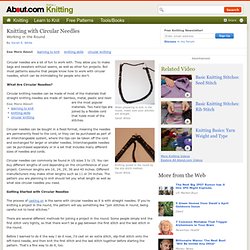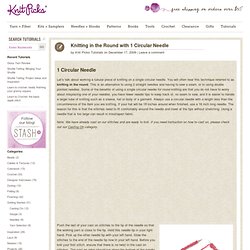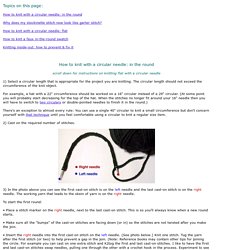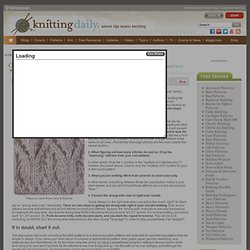

Knitting "In The Round" To avoid sewing seams, you can work in rounds using circular needles or double-pointed needles.

Circular Needles To work in rounds, cast your stitches on one end of the needle the same as you would on a straight needle. Check to make sure that the cast-on lays flat and smooth and is not twisted. Knitting With Circular Needles. Circular needles are a lot of fun to work with.

They allow you to make bags and sweaters without seams, as well as other fun projects. But most patterns assume that people know how to work with circular needles, which can be intimidating for people who don't. What Are Circular Needles? Circular knitting needles can be made of most of the materials that straight knitting needles are made of: bamboo, metal, plastic and resin are the most popular materials. Two hard tips are joined by a flexible cord that holds most of the stitches. Circular needles can be bought in a fixed format, meaning the needles are permanently fixed to the cord, or they can be purchased as part of an interchangeable system, where the tips can be taken off the cord and exchanged for larger or smaller needles.
Circular needles can commonly be found in US sizes 3 to 15. Knitting Small Diameters With 2 Circular Needles « Working Out Kinks & Fingering Yarn. Contributed by Paulette Vickery I love knitting small circumferences, like the crowns of hats or the thumbs of mittens, with 2 circular needles rather than a set of double-pointed needles.

Once you get the hang of it, the technique is much easier, less complicated, and not at all prone to having stitches fall off the needles. Plus you never have a little needle slip into the innards of a couch or roll merrily across the floor, managing to stay just out of reach. I’ll explain how to use two circular needles to knit small circumferences with a simple set of step-by-step instructions that will remove all of the confusion from the learning process. But first, take time to settle into your favorite knitting chair with a glass of your favorite libation at hand.
Learning the Process So that we are all working on the same project, let’s use a 16-inch (41 cm) circular needle to make a simple hat. First, divide your stitches onto 2 needles. It’s time to start knitting. Repeat the process. Knitting In The Round With 1 Circular Needle - How To Knit Tutorials from KnitPicks. Let’s talk about working a tubular piece of knitting on a single circular needle.

You will often hear this technique referred to as knitting in the round. This is an alternative to using 2 straight needles and having to sew a seam, or to using double pointed needles. Some of the benefits of using a single circular needle for round knitting are that you do not have to worry about misplacing one of your needles, you have fewer needle tips to keep track of, no seam to sew, and it is easier to handle a larger tube of knitting such as a sleeve, hat or body of a garment. Always use a circular needle with a length less than the circumference of the item you are knitting. If your hat will be 18 inches around when finished, use a 16 inch long needle. How To Knit With One Circular Needle. Topics on this page:

Joining Circular Knitting: The 3-In-1 TECHjoin. Includes a how-to Joining the first round of casting-on for circular knitting can get ugly.

There is a horrid loose stitch where the join occurs, as well as a "jog. " The tail gets unwound and makes the loose stitch even looser, while working in the tail has the potential to make a mess of the cast-on edge. Converting Stitch Patterns for Working in the Round. Papyrus Lace from Lace & Eyelets Continuing our little "use your stitch dictionary like a cookbook" series...

Traditionally, stitches in a stitch dictionary are presented for knitting flat (back and forth in rows). If you want to use one of the stitches for something knitted in the round (a sock, say, or a hat), then you have to do a little bit of conversion magic. Here are the basic conversion steps: 1. Some patterns are easy to convert from rows to rounds; some can be mind-bendingly difficult. 2. In other words: Drop the Y number in the "multiple of X stitches plus Y" notation discussed above. 3. In other words, everything between those two punctuation marks is your stitch repeat, and you will knit just those stitches around and around your "tube. " 4. You're always on the right side when you knit in the round, right? The steps given above for converting flat stitch patterns to in-the-round stitch patterns will work well for symmetrical patterns that are simple in design. Knitting Straight On A Circular Needle.